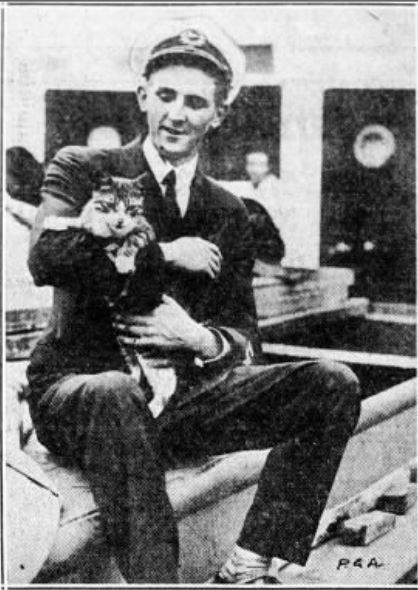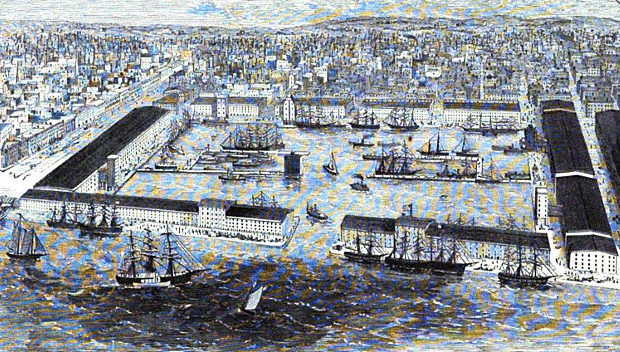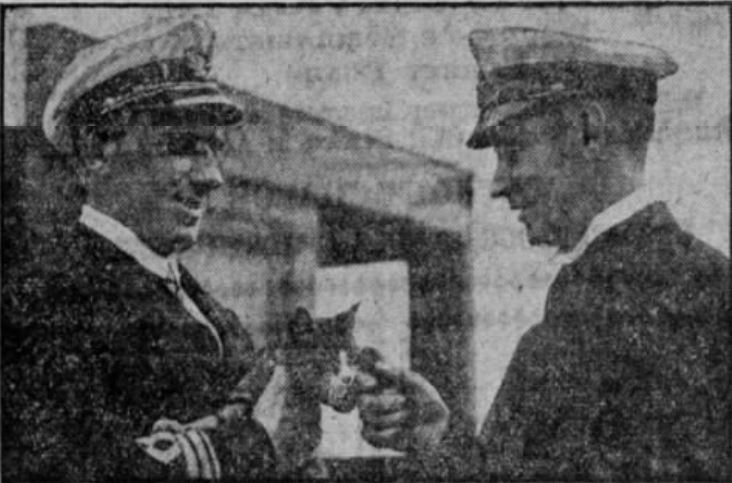
Many newspapers took photos of Olaf the Viking cat upon his ship’s arrival in Brooklyn. Here he is with Fourth Mate Hjalmar Larson.
“A mascot there was who almost wasn’t
But he has the life he almost hasn’t.
And the fact is this:
Though he’s somewhat wizened,
Though he almost isn’t—
He is.” — Angus MacGregor, Hartford Courant, October 12, 1930
An old maritime superstition was that if a mascot was lost at sea, a member of the crew would be lost shortly thereafter. Even worse, a lost mascot on a maiden voyage spelled constant disaster for the ship in the future. That is why when Olaf the cat fell overboard on the Sud Americano’s maiden voyage from Kiel, Germany, to Brooklyn, the captain and crew did not hesitate to attempt a daring rescue.
Olaf was described in The New York Times as a “blond Viking” with “tramp traits” who attached himself to the sailors of the South American liner, Sud Americano. The twin-screw steamer was built in Kiel, and was scheduled to go into service as an express passenger and freight liner out of Brooklyn to Rio de Jeneiro, Montevideo and Buenas Aires. Sud Americano and its sister ship, Sud Expresso, were operated by Garcia & Diaz, of Pier 44 in Red Hook, Brooklyn.
Refusing to be left behind on the ship’s maiden voyage to New York, the orange-striped tabby cat reportedly eliminated his competition—a ship mascot parrot named Juan—and signed on as the new official mascot of the Sud Americano. For the next few days, Ofaf prowled all over the boat, inspecting the saloons and staterooms, introducing himself to the men in the engine room, and basically expressing his appreciation of new role in general.
On the morning of July 2, 1929, when the ship was about 800 miles east of New York, Olaf was sunning himself on the foredeck when he was swept overboard by a heavy swell. According to the August 1929 issue of The Lookout, which was published by Seaman’s Church Institute of New York, the watchman saw Olaf get carried out to sea and immediately cried out, “Cat overboard!” Captain Bjor Boettger asked if it was the ship’s cat and ordered an immediate rescue.
First he telegraphed to the engine room for “stop” and “slow astern.” Then he instructed Chief Officer S. Anderson and six oarsmen to man the after lifeboat. The men, including Fourth Mate Hjalmar Larson, lowered the lifeboat in record time and pulled at the oars hard against the heavy seas, turning the boat toward the small dark object bobbing up and down in the waves.
Despite the swells, Olaf swam courageously for about 15 minutes as one would expect a seafaring cat to do, until one of the sailors scooped him up by the end of an oar. Upon returning the waterlogged Olaf to the ship, two “hefty Norwegian sailors,” under the direction of the Officer T. Anderson, started pumping air into his lungs and salt water out, following instructions for humans in the ship’s first-aid manual.
After resuscitating the cat, the sailors wrapped Olaf in a blanket and brought him to the engine room to dry out. Later that night, the crew threw a large party on the ship to celebrate the heroic rescue.

The Dutch established the village of Red Hook (Roode Hoek) in 1636, making it one of the earliest areas in Brooklyn to be settled. The area was named for its red clay soil and the hook shape of its peninsular corner that projects into the East River. By the 1850s, Red Hook was one of the busiest ports in the country.
Several days after the rescue, the Sud Americano steamed up to Pier 44 at the foot of Conover Street, with Olaf reportedly standing in the bow, head and tail held high, purring. When Manuel Diaz of Garcia & Diaz heard about the rescue, he said the Spanish Humane Society would undoubtedly award medals to the sailors who rescued him.
Many New York and Associated Press reporters came to interview Olaf, take his picture, and offer praise for him and his fellow officers. As a reporter for the Oakland Tribune (California) wrote, “We shall have to thank Olaf for new proof that men are interested in things which are not sensational and sordid. The sailors who went to the rescue and the captain who turned the ship back are surely other fellows worth knowing. Most of us would like to sail with that bunch.”
Rescue Prepares Crew for Lifeboat Race
Two months after Olaf’s rescue, the crew of the Sud Americano took part in the third annual international lifeboat race on the Hudson River. The race was sponsored by the Neptune Association, an organization of shipmasters and dock officers who recognized the need for better lifeboat skills for rescue and emergency work at sea.
On September 2, 1929, crowds of people lined up from 86th Street to 126th Street to watch the crews from various passenger ships compete in the two-mile race. As reported in The New York Times, the Garcia and Diaz lifeboat crew from the new motor freighter Sud Americano pulled to victory against seven competitors, with a winning time of 17 minutes and 11 seconds.
On September 6, William H. Todd of the Todd Shipyards Corporation presented the Todd lifeboat racing trophy to the crew at a luncheon aboard the ship at Pier 44. Captain C.A. McAllister, president of the American Bureau of Shipping and referee, inferred that the crew may have won because they were all under the age of 30 and “they were Norsemen whose ancestors were rowing boats while some of ours were shooting bows and arrows.”
Other news articles reported that the crew cheated by spreading grease on the bottom of the boat. But maybe the crew of the Sud Americano won simply because they had recent lifeboat practice with Olaf.

Here are the men of the Sud Americano during their winning lifeboat race on the Hudson River.

Olaf with Captain Bjor Boettger (left) in Brooklyn.
About a year after the rescue, a reporter from the Hartford Courant asked Captain Boettger why he thought his ship was having such good luck with the weather and the crew. The captain reached under the mess table and grabbed Olaf for the reporter to see. “Olaf is the plan this ship sails under,” he said. “We saved Olaf’s life, and he’s bringing us good luck in exchange.”
The Sud Americano Meets German Sub U-558 in 1941
Shortly after the Sud Americano went into service, she and her sister ship were returned to their builders in Kiel for failure to reach the contracted speed. The ship was renamed Schleswig and some time later, was under charter to the Blue Star Line of London as Yakima Star. In 1934 she was re-engined and lengthened; her two funnels were replaced by a single one, and she renamed Weser for Norddeutscher Lloyd, Bremen.
In October 1940 she was captured while attempting to run the British blockade by HMCS Prince Robert. The Weser was taken over by the Ministry of War Transport, handed over to Merchant Marine Ltd, Ottawa, and renamed Vancouver Island . This was to be her last name.
On October 15, 1941, Vancouver Island was torpedoed by German submarine U-588 under the command of Günther Krech. The ship sank in the North Atlantic west of Ireland. On 31 October, a lifeboat with the bodies of two officers from the ship was found by a British warship. Master Eric Lacey Roper, 64 crew members, eight gunners, and 32 passengers were lost. There was no mention of a mascot.



